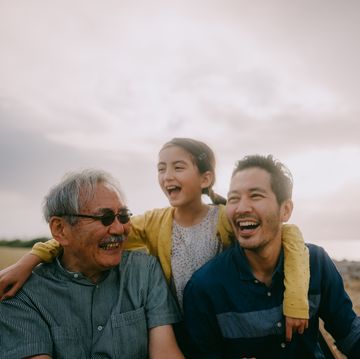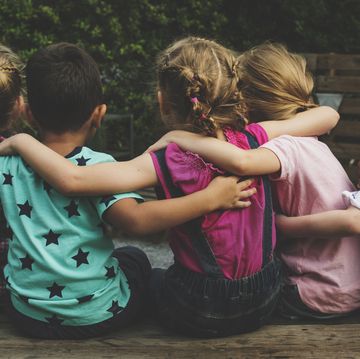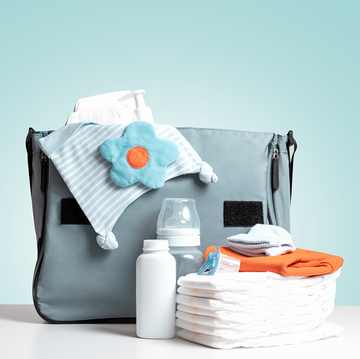Molly Rae Bock remembers the exact moment it really hit her that she and her then-2-year-old son, Ollie, were alone and without support in the midst of an uncertain pandemic. She had thought she was in a good place as a single mom with two jobs and Ollie in full-time daycare. When the pandemic hit, like many, she was sure it would be over within a month. Instead, the pandemic made it so Bock was unable to continue her work as a nanny. Both jobs offered to pay her for varied lengths of time, until one family eventually moved out of state, closing her employment after severance pay.
Eventually, her son could no longer go to daycare, and he soon started exhibiting behaviors that worried her. He started crying all the time, wanting his friends and his teacher. He didn’t want to color or play with toys or watch TV. “I had to teach myself I could never fall completely asleep,” she says, “because as soon as he stepped out of his room, I had to be alert and wake up because he could get into anything.”
Bock wasn’t alone in feeling this way. Last year, as the pandemic raged on and kids were home from in-person school and daycare, many parents and caregivers struggled with how to deal with changing behaviors, signs that kids, too, were struggling. Studies indicate that the effects of mental illness on children during the pandemic are deepening because of the isolation.
Now, in most of the country, school has resumed in-person, and vaccines have arrived, but the picture is far from rosy. Uncertainty abounds. Kids are reeling from witnessing adults feuding over vaccine and mask mandates, compounding stress and confusion. Even as their health is at risk, kids often have no voice in the school rules and health policies, though many of them have lots of opinions and feelings about it. Sudden quarantines affect kids’ need for consistency. Many schools are also doing socially distanced lunches, which means less time for kids to make friends. Changes in the classroom setup to accommodate social distancing can also lead to feelings of instability. Parents and caregivers are looking for ways to equip kids with the tools they need to deal with all the changes that come with going to school in an ongoing pandemic.
They may also be looking for support for themselves. It’s more than discouraging to look ahead to another year of more of the same: COVID cases, classroom quarantines, finding a clean mask when it’s time to head out the door. Imani Romney-Rosa Chapman and her wife are parents to 3 children ages 6, 15 and 19. They live in New York City and they struggled with the physical space needed for everyone to have privacy and participate effectively in their respective jobs and schooling. Chapman herself felt an imbalance in her life. “Most days I was attending to other people’s needs 18 hours a day,” she says. “It was stressful. It took a full pandemic year to say that you risk everything by continuing to work this way.”
Teaching kids how to tackle the changes and uncertainty, mentally and psychologically, is more important than ever. On top of all of that, caregivers need to take care of ourselves as we juggle the stress of parenting during trauma. I spoke with licensed family therapist and registered play therapist Sarah Harris, LMFT-S, RPT-S, BC-TMH, for some actionable tips for parents and caregivers on how to support your kids during this difficult time, while keeping your own head above water.
Be aware of your mindset as the parent or caregiver.
Try your best to accept the uncertainty that the change will happen. As hard as it can be, try not to subconsciously project your feelings of stress on your kids. We’re in unpredictable times with changing information. Treat changes like waves in the ocean. Since you can’t control how fast they come, it’s best to let them wash over you and just keep paddling.
Use mindfulness practices to stay grounded in the current moment.
It’s important to prepare for the future but not stress too much about it (which is so much easier said than done). Try to live in the present and not worry about “what ifs,” like what if your kids don’t get to be in-person all year. Find an emotional anchor. It could be a meditation practice (e.g. Insight Timer, Sesame Street Meditations, and Wellemental, which is designed for diverse kids), diaphragmatic breathing, body scans or Progressive Muscle Relaxation.
Keep schedules and routines as consistent as possible.
Kids need predictability. “You can’t control what’s going on outside the house, but you can manage some of what’s going on inside,” Harris notes. Morning prep routines, after-school relaxation time and bedtime rituals can be anchors that kids rely on in uncertain times.
Schedule emotional check-ins with the whole family.
Try to carve out weekly times to meet together as a family. Start with a compliment for each person and chat about what’s worrying each person that week. This can also be done before movie nights or taco nights to tie it to something fun.
Create consistent time to have conversations with your kids.
Listen more than you talk and be sure to acknowledge their feelings. Kids may not always have the words to express themselves, but you can reinforce their feelings. “Sounds like you’re disappointed that you’re not able to eat lunch with your friends,” or, “Looks like you’re upset because you can’t see your friends” are just a few conversation reinforcers to help them identify their feelings. “It’s important to normalize and channel feelings through mindfulness practices,” Harris says. “Teach kids deep breathing (Inhale: “I am strong,” Exhale: “I feel scared”). They can also jump on the trampoline to get their feelings out or draw a picture to show how they’re feeling.”
Tease out the fun, as hard as it might be.
We play “Monster in the House.” My son built mini forts all around that he called “Grandma’s House” and “Grandpa’s House,” and we raced to each one to escape the monster. He’s been watching lots of Trolls, but this can also be an indication of how he feels about the real monster outside: COVID.
Resist pressure to rush to a solution with kids, especially in regards to changes at school that might not have an immediate solution.
Encourage them to flex their own problem-solving muscles. If school goes virtual because of a positive case of COVID, encourage your child to brainstorm with you a schedule for the day that works for them and you. By supporting them in coming up with ways to cope that work for them, they’re more likely to take ownership over the day and carve out necessary downtime for them and you.
Get out the art supplies and old magazines and make a Family Feelings Board.
“On one side, choose pictures to show how your family (including parents) is feeling about the pandemic,” Harris advises. “On the other side, choose pictures to show how your family wants to feel, like envisioning that your kids are making friends at school, that they like their new teacher and that they feel safe. This teaches kids that it’s ok to have these feelings but there is hope.”
Keep the talks going.
“Be equipped with conversation starters for kids that acknowledge what happened first and end with open ended questions,” Harris recommends. A few are:
- ”It seems like you had a rough day at school. Can you tell me about it?”
- “I got a message from your teacher that your classmate is COVID positive. What went through your mind when you heard that? What did your body feel?” (It’s important to acknowledge how stressful this one can be for the whole family since they may have to quarantine)
- For older kids: “Help me understand what school is like right now.”
Focus on your own mental health needs, so that you can be equipped to parent through this traumatic experience.
“Find time to ground yourself,” Harris says. “One quick way to do this is saying a mantra or positive affirmation as you use your thumb to tap each finger on your hand. e.g. Peace begins with me, I am doing the best that I can for my child, I have patience, I listen to understand.If you don’t already have one, consider getting a therapist (some have sliding scale options for payment if you don’t have insurance). When you’re grounded, you have more clarity on how to parent through this and how to empathize with your child.”
Stick to a structure for yourself.
“Plan the next day as much as you can from the night before,” Harris says. Make sure to schedule in time to focus on caring for yourself, even if it’s just 15 minutes per day.
Harris also recommends keeping an eye out for depression and anxiety, and knowing the signs that your child should start therapy. “Big changes in sleep and eating can indicate a problem. Incessantly talking about the pandemic can also be a sign that they may need professional help, especially if they’re asking lots of “what if” questions,” she notes. “Depression can show up as lower energy, crying all the time, saying they don’t want to be on this earth anymore and more.”
Keeping an eye out for suicidal ideations and self-harm can be especially life-saving. Sometimes, parents or caregivers look for obvious signs and may miss the more subtle ones.
“Some of the more subtle signs of suicidal ideation can be giving away belongings, not making plans for the future because “I don’t know if I will be around,” indifference about consequences of current actions e.g. grades, job, personal care neglect, e.g. not showering, engaging in reckless behaviors such as risky driving, increased or new use of drugs and/or alcohol, or unusual purchases of objects which can be used in self-harm such as a gun or knife,” Harris says. “Some more obvious signs of self-harm can be banging their head on a hard surface, scratching the skin with a pencil or any object, burning, cutting with a razor blade, or pinching themself.”
If your child is talking about any of this, take it seriously, dig deeper and listen to them, while investigating if they have a plan to self-harm or try to commit suicide. “It’s OK if you look silly asking about it,” Harris says. “It’s worth the risk. They may be reaching out,” Harris cautions. Don’t be afraid to get professional help, even if you’re not sure if you should.
Bock tried a few tactics to meet Ollie’s changing needs. She leaned on friends with cars and got Ollie outside by taking day trips to open parks and other places where he could explore outside safely. Bock’s biggest piece of advice for parents is to seek out community. She found friends and other parents who were also looking for safe play for their kids. “If you think you’re alone, you’re not,” she says.
Chapman also found finding community for her kids useful. She says school helped a lot with her 6-year-old, who was feeling upset that people had less time for her. “Her teachers were able to do a lot with her in places where she felt sad, ignored, unheard and unseen,” Chapman says. “Having two additional adults who could help her navigate that was helpful.” She also sought out safe friends for her 6-year-old, separate from the academic framework. For her family, schedules were also key to order in their home.
As we get adjusted to the rhythms of the mid-school year in the midst of a sea of change, parents and caregivers need to be kind to themselves. You’re doing the best you can under traumatic circumstances. Leaning on each other during this difficult time is key to us finding a way through it all.













